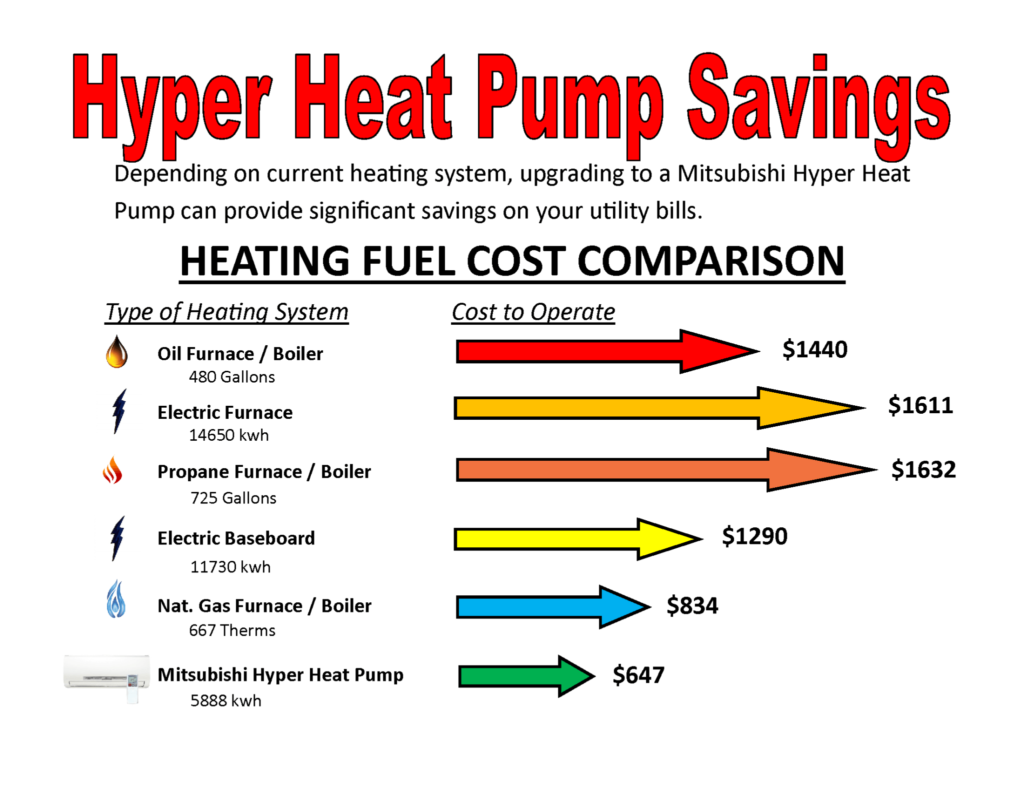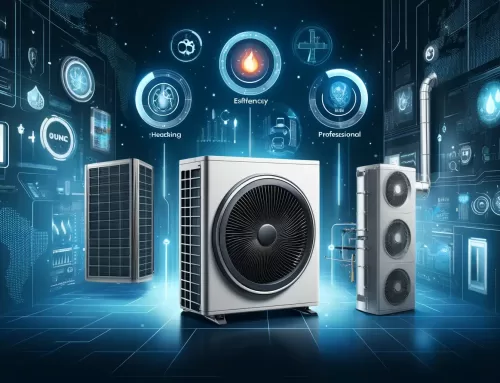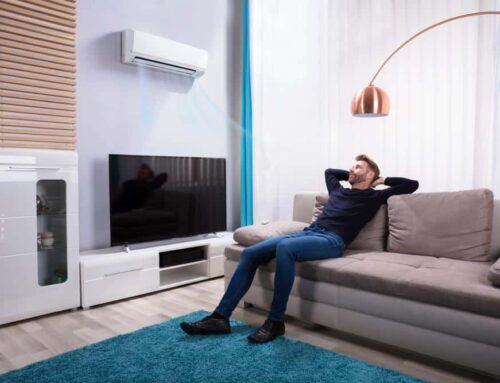What is Mitsubishi Hyper Heating?

Mitsubishi Hyper Heating is what we call a cold climate heat pump that heats & cools your home without the use of fossil fuels. These systems are using cutting edge technology that eliminates the use of fossil fuels and dramatically reduces the monthly cost of operation.
Will a Mitsubishi Hyper Heating System Also Work as an Air Conditioner?
The Mitsubishi Hyper Heating System, which is also called a heat pump, is an independent, two-part appliance that uses electricity and refrigeration technology to heat and cool a wide range of places, including homes, businesses, and other places. A heat pump consists of two components: an outside condenser unit, which generates the heating or cooling for a home, and an interior unit, which brings warm or cool air inside the home. The condenser unit is often located outside the residence. People often call heat pumps “mini-splits” because the condenser and air handler are “split” or separated from each other by the refrigerant line. Because ductwork is not required, heat pumps are sometimes referred to as “ductless.” This is due to the fact that ductwork is not required, but it is possible to use ductwork. Heat pumps offer extremely high efficiency rates, as well as the opportunity to provide heating and cooling without the need for ductwork in the home (ductwork can be used).

How a Mitsubishi Hyper Heating System Works
We are your local Mitsubishi Diamond Preferred Dealer
Great example of what the equipment looks like.

Mitsubishi Hyper Heating System Equipment Examples
What are the benefits of having a Mitsubishi Hyper Heating System?
Because a Mitsubishi Hyper Heat system uses electricity for power rather than for the generation of heat, it offers a remarkably high efficiency rate. When using traditional resistive electric heat – such as electric baseboard or space heaters, for instance – the amount of heat generated is proportional to the amount of electricity used: one unit of heat per unit of electricity for 100% efficiency.
Mitsubishi Hyper Heating System Costs Graph

The efficiency rate is significantly improved by using a technique from Mitsubishi called Hyper Heating. Only the two fans (evaporator and condenser), the compressor, and the pump that are used to concentrate heat from the outside and deliver it into your home are powered by the electricity that is used. The Mitsubishi Hyper Heating system has an efficiency rate that is greater than 300% and is able to produce more than three units of heat for each and every unit of power that is consumed. The seasonal efficiency rate of the Mitsubishi Hyper Heat is just around 285%. This is due to the fact that the average temperature in New York during the winter is 24.5 degrees.
This will result in decreased monthly utility expenditures while maintaining a pleasant house. Although running a Mitsubishi Hyper Heating system won’t put a significant dent in your budget, you may expect to see an increase in your monthly power bill for each outside unit that remains operational within the house. However, this would eliminate the expenditures associated with acquiring oil, gas, or propane. If you are using a primary heating system such as oil, gas, or propane in addition to a Mitsubishi Hyper Heating system, you will find additional savings by using the heat pump to offset the use of the primary fuel: one heat pump can offset up to 300 gallons of oil in a typical home, saving money on expensive fossil fuels. If you are only using the Mitsubishi Hyper Heating system, you will not find these additional savings. In addition, heat pumps will assist lower the carbon footprint of your property in this particular approach.
Example: If oil cost $2.75 per gallon then heating your home with a Mitsubishi Hyper Heating system is equivalent to heating your home with oil for $1.44 per gallon, or for 48% less.
Does a Mitsubishi Hyper Heating System Stop Working When It Gets Really Cold?
The efficiency rate of the heat pump manufactured by Mitsubishi Hyper HeatTM will begin to diminish at a temperature of around 2 degrees Fahrenheit. You will receive around 87% of the unit’s output when the temperature is -2 degrees. At a temperature of -13 degrees, the output of the device will be around 76% of its maximum. It is not apparent what temperature the machine will reach before it completely stops operating. To put that theory to the test with the Hyper HeatTM heat pumps, we have not yet had a day with temperatures low enough. There is evidence provided by Mitsubishi that specifies a stopping point of -18 degrees.
A heat pump will need to work harder to keep up with the rapid loss of heat that occurs in older homes that have less insulation, significant levels of heat loss, or drafts. This is because older homes are less efficient at retaining heat. On the other hand, many newer homes have better insulation and are built so that less heat escapes. The heat that is made by a heat pump stays in the house, which helps the system work better.
How Does Using a Mitsubishi Hyper Heating System Effect Electricity Costs?
As a result of the fact that your new system is the only one that needs power and that you no longer have to pay for any fossil fuels, the amount of electricity that is used is somewhat greater. Because the Mitsubishi Hyper Heating system also makes cool air, you don’t need a regular air conditioner in the summer. This makes a big difference in how much power you need for air conditioning.

What is a heat pump water heater?
A heat pump water heater uses the same heat pump technology described above to heat a home’s domestic hot water. Heat pump water heaters are very well-insulated, and water can hold heat very well. Heat pump water heaters provide hot water at a very low operating cost, usually $15 or less per month.

Residential Water Heater with the panel removed for repairs or adjustments to the thermostat.
Factors that determine the cost of an air source heat pump
Total installation cost for heat pump systems depends on the type of system (central vs. ductless), system size, quality of equipment, complexity of the installation, other services included and any extras that you may want to add.
Size of system
The size of the space that you want to heat and cool will determine how much it will cost you to have it installed. The usage of additional internal heads and maybe the utilization of machinery that generates a higher level of BTUs per unit are the primary contributors to the increased expenses associated with ductless systems. For instance, if your project is a modest one that is just focused on heating and cooling a few rooms with ductless units, the total size of the system will be minimal, and the expenses will be lower as well. If you want to heat and cool your whole house with ductless units, you’ll need a system that’s quite a bit more powerful than the average one. When it comes to central systems, the total amount of living space that the system is responsible for heating and cooling is frequently the determining factor in project costs.
Equipment quality
Any improvement to the technology in your house will come with a selection of different pieces of hardware from which to pick. Some of the equipment is of a poorer quality than other pieces (this kind of equipment is frequently referred to as “contractor grade”). It’s possible that the effectiveness of the system and the standing of the maker are the driving forces behind this. The Heating Seasonal Performance Factor, often known as HSPF, the Seasonal Energy Efficiency Rating, or SEER, and a Sound Rating are some of the ratings that are linked with heat pumps and are used to reflect the quality of the equipment.
It is a heat pump. The HSPF is a measurement of how efficiently it can heat an area, while the SEER measures how efficiently it can cool an area. The sound rating of an air source heat pump is nothing more than a method of indicating the amount of noise that it generates when it is functioning. In general, the cost of the equipment will be higher if it has better ratings in these categories.
Installation complexity
Installers have issues when they are tasked with installing ductless systems in each living area because they need to select sites for storing the internal and exterior units and for routing the lines around the home to link these units. When the lines need to be run via an attic or crawl space, there is sometimes simple access to such areas, but other times, a far more difficult installation method is necessary. Work on the second and third levels often necessitates the utilization of specialized tools, which might result in additional expenses for the customer.
As was said earlier, the cost of central systems often does not vary quite as much as other types of systems due to the fact that they are simply linked with an existing distribution system. Having said that, there is a possibility that the expenses may climb significantly if there are any modifications that need to be made to the ducting.
Other services and upgrades
It is usual practice for installers to include the removal and disposal of any previously installed equipment in their services. When installing a new oil heating system, some contractors could include the removal and disposal of the oil tank in the price, while others would tack on an additional fee for that service. This may cost anywhere from $500 to $1,000, but it can be a worthwhile investment because it might be difficult to sell a property if it has an unused oil tank in it because an oil tank is considered to be a kind of hazardous waste.
You have the option of adding a variety of extra features to central systems, such as humidifiers and air filtration systems, among other bells and whistles. Humidifiers hook up to your home’s plumbing so you can change how much moisture is in the air and get it closer to what you want. During the colder months, this might be an extremely helpful resource. Air filtration systems can clean the air by using UV lights or filter cartridges with a thicker layer of material. There is an additional fee associated with each of these features, which ranges anywhere from $250 to $1,000 on average.
Type of system: ducted vs. ductless
The cost of your ducted or ductless air source heat pump system will be determined by the type of air source heat pump that you install in your home as well as whether or not that system is ducted.
Ducted (or central) systems have a tendency to be more expensive, but their costs are more standardized. This is because the installer only needs to replace your old air handling unit, which is already connected to your existing ductwork, with an air source heat pump. This should not take more than a day. If your property does not already have a duct system, the cost of establishing a comprehensive duct network in your home can range anywhere from $15,000 to $30,000. This is a major additional expenditure. However, if you don’t want to pay the additional money or if you’re simply looking for supplemental heating for limited parts in your house, you may always choose to install a ductless heat pump system in your home. This is one option available to you.
When compared to the cost of installing a ducted system, the installation of a single ductless air source heat pump will be significantly cheaper. However, a single indoor ductless air source heat pump will not be able to adequately heat or cool your entire residence on its own. If you want to use this technology as your only way to heat and cool your home, the total cost of a ductless system will vary by a lot. This is because the number of interior and exterior units that your home needs will vary based on its features. Because these units will need to be put throughout the property in each zone that you want to heat or cool, the entire cost can vary quite a bit depending on the number of stories a home has, whether it be a single-story ranch home or a three-story townhouse.






Leave A Comment